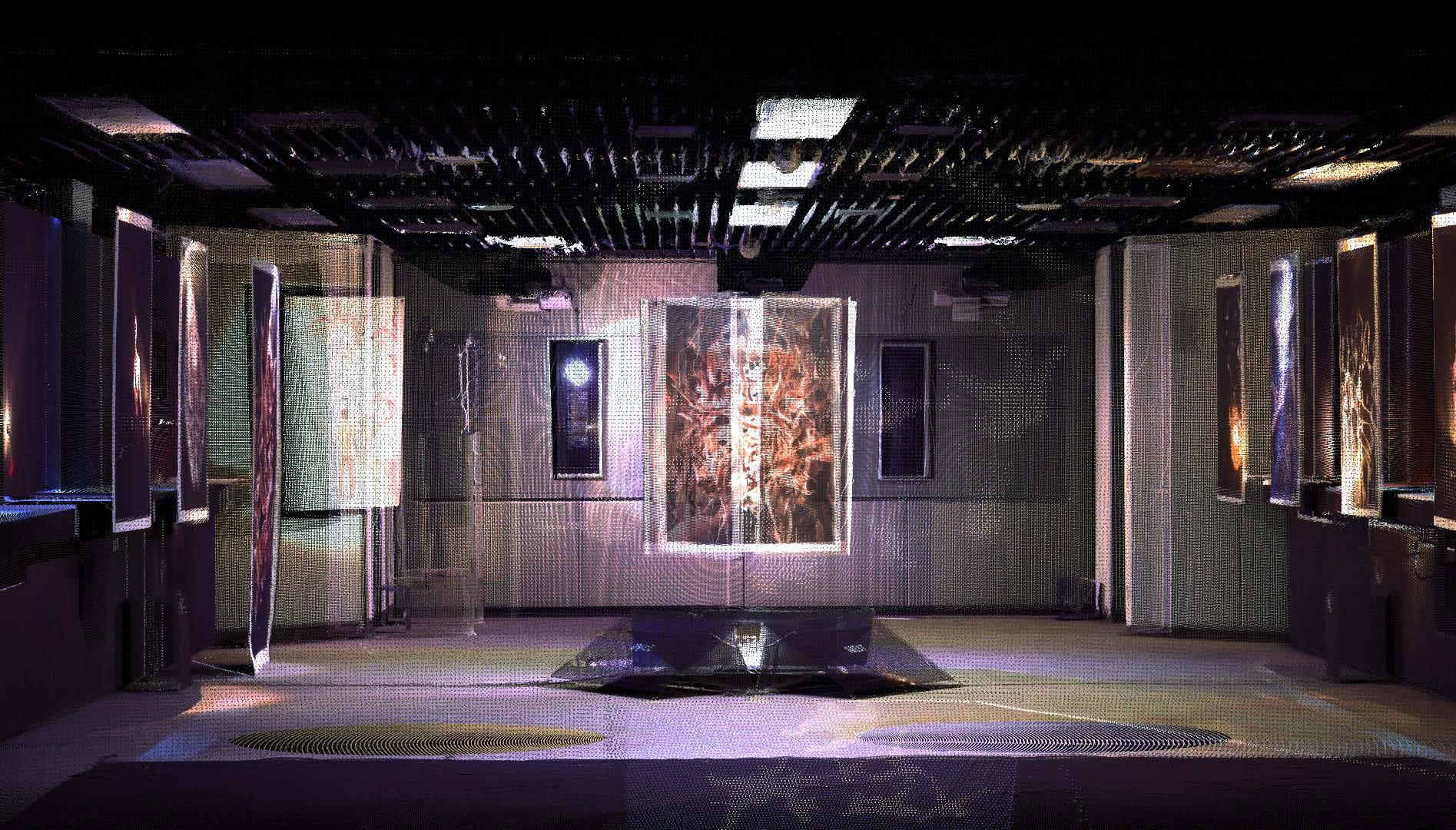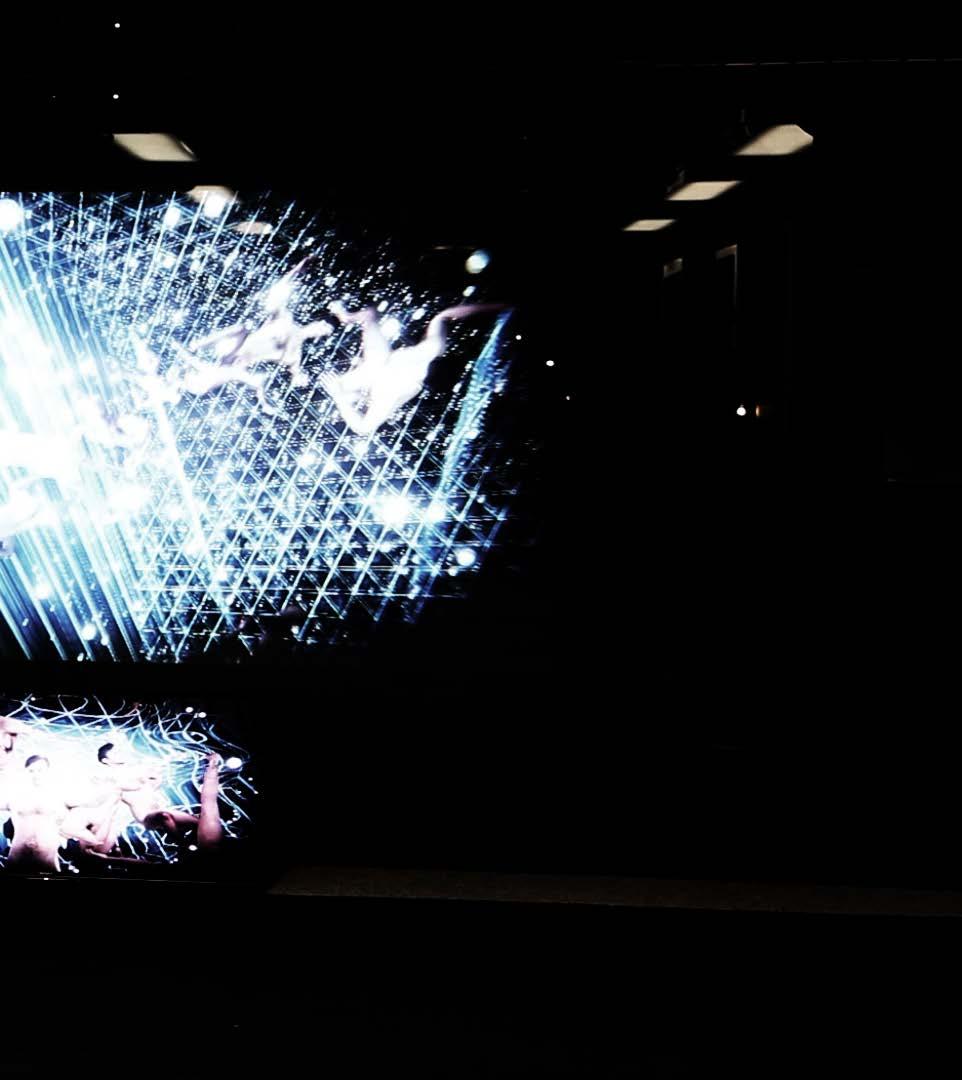
9 minute read
EMILIA
EMILIA The Trauma Machine
Cenk Güzeliş
Advertisement
A digital entity with neuro-optical machine vision designed to help people manage Post Traumatic Stress Disorder
Emilia, The Trauma Machine is a digital entity designed to help people who suffer from Post-Traumatic Stress Disorder (PTSD), particularly those with derealization disorder. Emilia is a neuro optical machine that uses apparatuses of capture and media to negotiate the symptoms of PTSD in virtual bodies and in virtual environments. This therapeutic tool was developed in the realm of machines and apparatuses of capture; that is, designed to (re-)wire body-mind-spaces for those who may have a distorted perception of reality.
The Host and Emilia invite you to the Trauma Machine to see the world of traumas from the virtual body of a traumatized person, Soren, the guest of the machine. One can inhabit his virtual body, to perceive the symptoms of trauma that have altered his perception of reality and of his body.

Avatar Therapy_1_Dila Kirmizitoprak in the interactive installa tion of the Trauma Machine, experiencing the scene of symptoms through the virtual eyes of Sören. Interacting with the virtual human - Emilia, to learn ho w to navigate with the virtual body of Sören inside the experie nce and gradually gain control over the disturbing symptoms of the PTSD. Photo: Cenk Güzeliş
Cenk Güzeliş is an Innsbruck-based architect and a new media artist. He graduated from the Academy of Fine Arts in Vienna and is currently a PhD Student and University Assistant at the Institute for Experimental Architecture ./studio3 at Innsbruck University where he researches interactive virtual environments with neuro-optical machine visions to help people who suffer from Post-Traumatic Stress Disorder, particularly those with derealization and depersonalization disorder. Güzeliş has worked in Computer Aided Manufacturing at the Platform for Analog and Digital Production, the Institute for Art and Architecture, and the Academy of Fine Arts Vienna, and he has led various LIDAR and Animation Workshops in Denmark and Austria. In 2016, as part of the team from the Innsbruck-based Architecture Practice LAAC, Güzeliş contributed to the Architectural Film Project, “Coexistence,” for the Montenegro Pavilion at the 15th Venice Architecture Biennale. His award-winning short films have been screened at festivals across Europe and the United States. In 2017, his short film “The Aleph,” based on the Jorge Luis Borges short story of the same name, received the Best Short Animation FX award at the 45th Boston Sci-Fi Film Festival.

Emilia, The Trauma Machine probes the notion of virtual bodies, virtual environments and their effect on human perception by designing visions for traumatized subjects. The machine also aims to see how immaterial micro virtual visions can serve as a playground to access possible new experiences in physical reality. The project asks itself, is it possible to reshape one’s life story by adding commentary to life’s events? The main interest is to construct a digital entity that can communicate with any traumatized subject and focus on the approach of transfer of experience from the virtual bodies to the biological bodies. The machine considers the immersiveness of the virtual space and virtual bodies and the application of ‘presence’ in PTSD therapy. By observing how guests interact with their virtual selves in the virtual spaces, Emilia observes the influence of technology in shaping personal identity1 . Emilia, The Trauma Machine utilizes technological immersion to create a virtual narrative site to reexperience trauma, to reformulate conditioning of stressful stimuli by offering the guests a canvas to relive a new life story.
A digital entity was designed to help people dealing with PTSD, particularly those who suffer from derealization disorder. Emilia is a neuro-optical machine that uses apparatuses of capture and media to negotiate the symptoms of PTSD in virtual bodies and in virtual environments. This therapeutic tool was developed in the realm of machines and apparatuses of capture, designed to wire body-mindspaces for those with a distorted perception of reality. The trauma machine aims to show the world of traumas from the virtual body of a traumatized person.
Emilia is based on a real person, a professional actress at theBurg Theater. We scanned Emilia at a photogrammetry studio and at that time, she was frozen, without eyes, ears, or programming. There was no ghost in the machine. To create her human body, she needed eyes, ears, and a means to interact. Over time, Emilia became a ghost hunter equipped with many tools and sensors such as motion tracking devices, voice recognition systems, gesture recCenk Güzeliş ognition, and spatial tracking in real time, which allows her to dive into our physical reality and conversely bring us to her digital world. She started seeing us and communicating with us. She is a product emerged from the realm of machines and apparatuses of capture, designed to wire body-mind-spaces for those with a distorted perception of reality – a digital identity born from the era of object-oriented architecture.
Her therapy looks at the construction of the self-image and self-narrative in the virtual spaces. It connects this process to the explanation of the effect of therapy in virtual environments as a treatment method which uses motion capture devices, depth sensors, voice recognition to treat anxiety disorders.
Emilia’s algorithmic architecture of screens positions her as the catalyst. In order to unlock the frozen energy bound up in the nervous system, nervous impulses are channeled into new circuits and coordinated with machines & media. Her neuro-optical machine vision favors the brain, the eye, the nervous system, the amygdala, and the gaps between the axons to modify the responsiveness of circuit at a neural chemical level. She insists on a disjuncture between the camera apparatus and the human eye, for her vision is an activity beyond and outside of the human subject. It is a product emerging from the realm of machines and apparatuses of capture, one that retroactively conditions & manufactures human vision.2
How is one to face this neural optical apparatus? How can critical practices intervene in this seemingly smooth multi-channel network where emotional pain, nervous stimulation, and visual perception are seamlessly integrated to condition human beings? What does it mean to encounter the realities of human suffering? Where are the limits of human perception? It is my challenge not only to expand the limits of human vision but to produce new ideas of species and territories of building that are immaterial, literally linked through nervous stimulation and speculation.
1_ Original Research ARTICLE Frontiers in ICT, 07 December 2017 | https://doi.org/10.3389/ fict.2017.00027 Trauma and Self-Narrative in Virtual Reality: Toward Recreating a Healthier Mind
2_ Pasquinelli, Mateo. “Alleys of Your Mind: Augmented Intelligence and its Traumas” 2015 meson press – The Trauma Machine: Demos, Immersive Technologies and the Politics of Simulation 53 Orit Halpern
3_ Perry, Philip. Been Traumatized? 2016. “Here‘s How PTSD Rewires the Brain Learn what PTSD does to the brain, and how someone can bounce back” https:// bigthink.com/philip- perry/been-traumatized- here-is-how-ptsdrewires- the-brain
Lidar scan from the Installation at the Academy of Fine Arts in Vienna, 2018 Credit: Cenk Güzeliş
Trauma – Amygdala & The Avatar Therapies
When a trauma occurs, the reptilian brain takes over. The amygdala, an almond- shaped mass located deep in the brain, and the site of Emilia’s constructions, is responsible for survival-related threat identification, plus it tags memories with emotion. After trauma, the amygdala can get caught up in a highly alert and activated loop during which it looks for and perceives threats everywhere. When there is danger, the amygdala activates the fight or flight response. If the traumatic event is too much for the fight and flight mechanisms to cope with, the brain goes into a freeze state, a numbing response. All nonessential body and mind functions shut down3. What a person experiences during the symptoms of PTSD is the result of a frozen energy bound up within the amygdala.
The task of therapeutic immersion is therefore to unlock the frozen energy bound up within the nervous system by utilizing the apparatuses of capture and media. The Avatar therapies look at the construction of the self-image and self-narrative in the virtual spaces. It connects this process to the explanation of the effect of therapy in virtual environments as a treatment method, which uses motion capture devices, depth sensors, and voice recognition to treat anxiety disorders.
We invited Soren, the traumatized subject, to the photogrammetry studio to recreate him virtually. We used 50 cameras to capture him in one position. This technique


Image_1_ Scanning Emilia in the photogrammetry studio by OLN

Image_2_Digital Reconstruction of the guest in the machine
Image_3_ Motion Tracking in Green Screen Studio to construct 1:1 human motion for the virtual avatars inside the experience

Credits: Studio Totale in Vienna, Marvin Kanas
WATCH ON VIMEO
https://vimeo. com/300497983 allowed us to work with his body on a digital platform. His frozen body was rigged in software in order to be given motion. Using animation, we simulated his symptoms of floating – of watching himself as if in a movie, being detached from his body and his physical plane – in a virtual environment. We then dropped his virtual body into a scene of symptoms.
The camera that captures him in real time changes its position into a virtual camera that shoots from Soren’s eyes so that he can see his traumatic world from his virtual body. We confronted Soren with his symptoms and within that space of symptoms and gave him a new body that is attached to the rules of physics, which is the one that has control over the ones that are not attached to the physics.
Proprioception is the sense of the relative position of the body segments in relation to other body segments. The previously mentioned technique of enabling the subject to gain control over his virtual body, virtual environment, and the physics of that environment could help the subject develop his proprioception because the sense of proprioception is disturbed in many neurological disorders. Due to this, we scanned Soren‘s body without any clothing in order for him to observe the parts of his body in virtual. My aim is to resolve the unseen symptoms in virtual by giving them space – a virtual space that can merge with the physical one.
Soren did not know what was happening in his brain. He was frozen. Emilia‘s task in the machine is to assist Soren‘s virtual body and unlock the frozen energy bound up within his nervous system.



Avatar_Therapy_2_ This interactive scene is designed to shift t he point of view to the virtual hands of the avatar to see the world of trauma from a different perspect ive. The user is controlling the virtual cameras with a different bodily motion.








